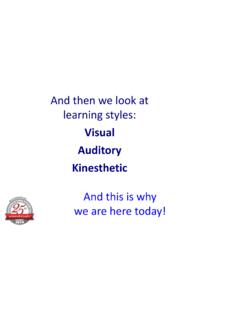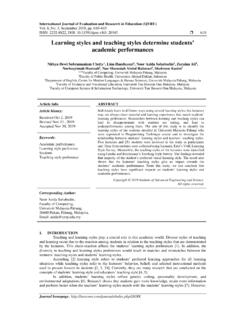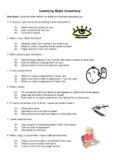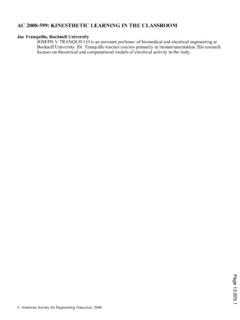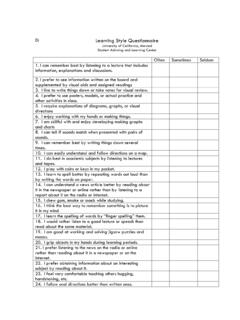Transcription of Learning Environments Designed According to Learning ...
1 Eurasian Journal of Educational Research, Issue 61, 2015, 61-80 Learning Environments Designed According to Learning Styles and Its Effects on Mathematics Achievement* Ay en ZEREM** Buket AKKOYUNLU** Suggested Citation: Ozerem, A., & Akkoyunlu, B. (2015). Learning Environments Designed According to Learning styles and its effects on mathematics achievement. Eurasian Journal of Educational Research, 61, 61-80. Abstract Problem Statement: While designing a Learning environment it is vital to think about learner characteristics ( Learning styles, approaches, motivation, etc.)
2 In order to promote effective Learning . The Learning environment and Learning process should be Designed not to enable students to learn in the same manner and at the same level, but rather Designed by giving thought to students existing Learning styles. Purpose of the Study: The aim of this study is to examine primary students and inspectors opinions on different Learning Environments Designed According to students Learning styles and its effects on students achievement. Method: Fifty-five seventh grade students and seven inspectors constituted the research sample.
3 The data were collected through an open-ended questionnaire; a mathematics achievement test and the Pat Wyman Personal Learning Style Inventory were used as data collection tools in the research. Since the group consisted of less than 30 participants, the Wilcoxon Signed Rank Test for Paired Samples was used. Findings and Results: The difference of pre-post test results of visual auditory learners, auditory- kinesthetic learners, and visual-auditory learners are statistically significant. When the ranked average of different grades and their sums are considered, the observed difference is in * This article has been produced from the doctorate thesis supervised by Prof.
4 Dr. Buket Akkoyunlu at the Division of Educational Administration, Supervision, Planning and Economics, Graduate School of Educational Sciences, Near East University. ** Dr., Near East University, ** Corresponding Author: Prof. Dr., Hacettepe University, Faculty of Education, Department of Computer Education and Instructional Technology, 62 Ay en zerem & Buket Akkoyunlu positive ranking, meaning it is in favor of post-test results. According to these results, different Learning Environments Designed for visual-auditory- kinesthetic learners have a positive effect on student grades.
5 The majority of the students stated that the aforementioned activities used in the mathematics lesson could also be used in other school subjects. Conclusions and Recommendations: Student responses emphasized that Learning Environments should be Designed According to student Learning styles. Inspectors underlined that Learning styles Designed According to students individual Learning styles may increase student success. In addition, inspectors thought that some of the advantages of designing Learning Environments According to students Learning styles included an opportunity to learn fairly, an increase in student motivation towards the lesson, and enabling students to learn at their own pace.
6 In the upcoming studies, student behaviors and motivations towards Environments Designed According to students Learning styles will be analyzed. Keywords: Learning styles, achievement, students' opinions Introduction Learning is a very complex process. One s general ability, cognitive process, emotions, motivation, developmental characteristics, readiness, previous experiences, social environment , and the culture of his/her community are variables that affect the process of Learning . Affected by so many factors, individuals have different Learning processes.
7 In a Learning environment there are many stimuli created by the teacher. A student collects the information that s/he chooses from among these stimuli. Additionally, every student might have different senses s/he prefers to use. When one student tries to learn by listening to the teacher, another might be interested in the behaviors of the teacher or the script and pictures of the book open in front of him/her. Every student has a different strategy of coding information to their long-term memory.
8 Some try to learn by giving meaning to them at once, whereas some try to learn by repeating. Some students can remember what they learned easily and quickly. Conversely, some have difficulty remembering and organizing what they know. Some students like Learning in groups, and some might find it disturbing (Erden & Altun, 2006). Researches on educational sciences have shown that there are Learning differences among students and the only way for Learning to take place in the proper sense is to find an individual s Learning style and arrange the Learning environment accordingly.
9 Learning differences have affected Learning and teaching processes, individualizing Learning processes and taking these Learning differences into the center of Learning . Students have their own methods of obtaining information and processing it: while some focus on data and operations, others are better at theories and mathematical models. For some, written and verbal explanations are more Eurasian Journal of Educational Research 63 effective for others it can be visual elements like drawings, shapes, and graphics.
10 Some learners prefer interactive Environments , while others might prefer working individually. All of these differences in Learning preferences are signs of their different Learning styles (Felder, 1996). The Learning style of an individual not only shows how s/he learns but also gives information about how to design a Learning environment . Although all the students in a class are at the same age, at the same developmental phase, and offered mutual chances by the teacher, different behaviors, Learning styles, and achievements in a class can be observed.










